Books
Except for a few that are very old and rare, you will probably find most of these on Amazon, eBay or through theatre bookshops. This listing is still under construction, and will grow week by week.
GENERAL
KINDLY LEAVE THE STAGE: THE STORY OF VARIETY 1919-1960, by Roger Wilmut. Methuen, 1985. Excellent history that often concentrates on the business side of Variety. Contains many routines and descriptions of acts. Some great names helped Wilmut with this book – the Acknowledgements include: Harold Berens, Norah Blaney, Douglas Byng, Reg Dixon, Arthur English, Serge Ganjou, Stanley Holloway, Nat Jackley, Nat Mills, Bob and Alf Pearson, Max Wall and Elsie Waters.
ROY HUDD’S BOOK OF MUSIC HALL, VARIETY AND SHOWBIZ ANECDOTES, by Roy Hudd. Robson Books, 1993. Anecdotes is the word – this is a compendium of funny backstage stories, often featuring the ebullient Hudd’s old pals (and why not?).
FUNNY WAY TO BE A HERO, by John Fisher. Frederick Muller, 1963 (revised and updated, with six new chapters, Preface Publishing, 2013). In my opinion the best book about Music Hall and Variety comedians ever written. I devoured this when I was young, reading and re-reading until the book was almost in tatters. Insightful, respectful, funny and beautifully-written, it was the first work to legitimize our side of the business and Fisher went on to produce many fine TV documentaries about his ‘heroes.’ Funny Way to be a Hero starts with Dan Leno and Little Tich, and goes on to examine the careers of Billy Bennett, Will Hay, the Crazy Gang, Lucan and McShane, Max Miller, the Formbys, Robb Wilton, Tommy Handley, Sid Field, Frank Randle, Jimmy James, Frankie Howerd, Norman Wisdom and many more, with fascinating diversions along the way, right up to (in the original edition) Morecambe and Wise and Ken Dodd.
GRACE, BEAUTY AND BANJOS: PECULIAR LIVES AND STRANGE TIMES OF MUSIC HALL AND VARIETY ARTISTES, by Michael Kilgarriff. Oberon Books, 1998. Scurrilous and vastly-entertaining collections of oddities and anecdotes about Variety performers. Though highly-opinionated and floridly-written, its still a book that is very hard to put down once opened.
FAMILY AFFAIRS, by George Robey. John Long Ltd, 1924. The ‘Prime Minister of Mirth’ from the early days of Music Hall continued to perform well into the Variety age. He was perhaps the first of his kind to appreciate the value of his name in terms of what would now be called merchandising. This book, one of a series that appeared under his name in the 1920s, is a collection of faintly amusing domestic escapades involving Robey and his ‘wife’ and pets etc. Mostly interesting to social historians as a portrait of British middle-class life at that time, perhaps. Similar collections by Robey include An Honest Living (1922) and Bits and Pieces (1935).
THE BRITISH FILM CATALOGUE 1895-1970, by Denis Gifford. David and Charles, 1973. Date, cast, credits and very brief synopsis of every single British entertainment movie made between those dates. Many Variety stars had their own film vehicles, of course, or appeared as supporting actors or comic relief in countless others. Includes all the musical quickie shorts made in the 1930s. Weighty and a bit hard to negotiate, but it should be on every Variety enthusiast’s (reinforced) bookshelf.
BRITAIN HAD TALENT, by Oliver Double. Palgrave Macmillan, 2012. Very interesting material about the 1950s and early 1960s, when Variety veterans found themselves often nonplussed by screaming fans while appearing on bills with the likes of new stars such as Adam Faith and Marty Wilde. Anecdotal and highly-entertaining.
JACK HYLTON PRESENTS, by Pamela W. Logan. BFI Publishing, 1995. The story of the bandleader and impresario’s adventures with Associated Rediffusion, for whom he made a huge number of television programmes with his pown production company in the 1950s. Notable because many of these programmes, in the Light Entertainment area, starred Variety performers such as Elsie and Doris Waters, the Crazy Gang, Jimmy Wheeler and Bransby Williams. Other shows starred Hylton’s girlfriend, singer Rosalina Neri.
BRITISH MUSIC HALL: AN ILLUSTRATED WHO’S WHO FROM 1850 TO THE PRESENT DAY, by Roy Busby. Paul Elek, 1976. Useful A-Z, lavishly illustrated. Though the stress is on Music Hall, most notable Variety artists are included, though the present-day (1976) entries contain an over-abundance of now-forgotten drag acts.
BRITISH CINEMA BOOK, edited by Robert Murphy. BFI/Palgrave Macmillan, 1997, 3rd Edn 2009. Part Three, British Cinema 1895-1939, has two excellent chapters discussing the influence of music hall and variety on British films: A Despicable Tradition? Quota Quickies in the 1930s by Lawrence Napper, and Low-Budget British Films in the 1930s by Linda Wood. Interesting points are made about how films that were primarily vehicles for variety stars of the day often represented a pretty accurate picture of working class life before the Second World War. Films featuring Max Miller, George Formby, Gracie Fields, Stanley Lupino, Lupino Lane, Flanagan and Allen, Sandy Powell, Arthur Lucan, Frank Randle and many others are mentioned.
BRITISH MUSIC HALL ON RECORD, by Brian Rust. General Gramophone Publications Ltd, 1979. This is basically a daunting-looking list of closely-typed names, titles, dates and catalogue numbers, with no visual appeal whatsoever. All the same, it is a fascinating and invaluable book for anyone who searches car boot sales etc for old 78rpm records. As Rust writes in the Introduction: ‘All the traceable records made by these performers, pioneers and relatively recent comers alike, are listed in this book. Household names such as Max Miller and George Formby mingle with barely-remembered folk such as Beth Tate and Nelson Jackson of a generation before. The scope is not limited to the rough “red nose” prototypes; included will also be found the records of such very urbane, sophisticated artists as Barclay Gammon, Tom Clare, Harold Montagu, Norman Long, Ernest Hastings, the Western brothers and Ronald Frankau. It may be argued that these do not relate to the earthy style of Gus Elen and Harry Champion, but both types of humour draw caricatures of an era that has passed.’ I find it indispensable, and have referred to it frequently for over 30 years. You may be lucky enough to get a copy on EBay – but it’ll cost you!
OLD TIME VARIETY, by Richard Anthony Baker. Remember When, 2011. Lively and anecdotal history of the Variety stage from just after the First World War to the 1960s. Extremely well illustrated, and with panels of biography breaking up the text.
THE LAUGHTERMAKERS: A QUEST FOR COMEDY, by David Nathan. Peter Owen, 1971. Journalist and critic Nathan concentrates on comedians in this fine book. Most are the stars of the day – 1971 – such as Morecambe and Wise, Pete and Dud and Marty Feldman, but he does chart the Variety background that informed all comics of that generation and also talks to some stars of an earlier generation, such as Ted Ray and Tommy Trinder.
HOORAY FOR JOLLYWOOD: THE LIFE OF JOHN E. BLAKELY AND THE MANCUNIAN FILM CORPORATION, by Philip Martin Williams and David L. Williams. History on Your Doorstep, 2006. Fascinating story of the Northern movie mogul who made comedies starring George Formby, Nat Jackley, Jimmy James, Norman Evans, Jewel and Warriss, Josef Locke, Sandy Powell, Tessie O’Shea and, of course, Frank Randle. Whatever one might think about the technical proficiency of Blakely’s films, they are of tremendous value for enshrining the work of so many great Variety stars.
CRAZY OMNIBUS, by Ronald Frankau. Grayson and Grayson, 1933. Collection of essays and sketches by the bald, gap-toothed, plummy-voiced comedian who made a big impact on radio in his day. Laboured and not very funny by today’s standards.
PURE FOLLY: THE STORY OF THE FOLLIES, by Fitzroy Gardner. Mills and Boon, 1909. The Follies, or British seaside Pierrot shows and burlesque concert parties, dated from the Harlequinade and was a fertile breeding-ground for future Variety stars. Written in an old-fashioned style so convoluted and quaint as to be almost unreadable. Illustrations – photographs and cartoons – are lovely, though.
STAGE DOOR SECRETS, by Dr Walford Bodie. Simpkin, Marshall, Hamilton, Kent and Co, no date (but obviously very early 1900s). Daft and outlandish stories from a master illusionist and charlatan. When challenged in court about his bogus medical qualifications Bodie claimed that the ‘M.D.’ he used after his name stood for Merry Devil. A curiosity.
TOP OF THE BILL: THE STORY OF THE LONDON PALLADIUM, by Ian Bevan. Frederick Muller, 1952. Workmanlike history of London’s most famous Variety theatre.
HOW TO BECOME A COMEDIAN, by Lupino Lane. Frederick Muller, 1945. This is probably my favourite book. Nowadays all a comedian needs is confidence, an appealing personality and plenty of good, original material, but back then an extraordinary number of skills had to be mastered before one was a fully-rounded comedian, according to Lane. One had to be able to juggle, fall downstairs and backwards off chairs, know dozens of dialects, function as a ventriloquist and instrumentalist, do hat tricks, and, it goes without saying, tap dance. Lane, creator of The Lambeth Walk, did all these things, as could most members of his astonishing family, entertainers since the 1700s and including West End luminary Stanley, actor Wallace and Hollywood star and director Ida. Beautifully illustrated with photographs and drawings (how to walk on your hands, how to fall down a flight of steps etc). This lovely book deserves to be reprinted.
Here’s a glimpse of a Lupino – the author’s Uncle Stanley – in a wonderful number from the 1938 movie Over She Goes. The tall, good-looking one is John Wood, and the one with glasses Laddie Cliff.
THE OLD TIME STARS’ BOOK OF COMEDY SKETCHES. Wolfe, 1971. Now mostly too dated to be at all funny, these sketches are of historical interest only. There are some of Bransby Williams’s Dickens monologues here, and the best is probably Harry Tate’s famous sketch from 1918, Motoring, which he toured his whole career.
IDOLS OF THE HALLS, by H. Chance Newton. Heath Cranton, 1928. This is rightly regarded as a kind of Bible of music hall books. H. Chance Newton was a drama critic with a love of low-life entertainment, and the value of ‘Idols’ is that he is describing acts – Vesta Tilley, Marie Lloyd, Dan Leno and the rest – he has seen many times, so it is very much a contemporary account. The era it covers is, of course, before twice-nightly Variety.
WINKLES AND CHAMPAGNE: COMEDIES AND TRAGEDIES OF THE MUSIC HALL, by M. Willson Disher. Batsford, 1938. Another classic, going back to the earliest days of the Halls. Behind-the-scenes stories about the great stars, with plenty of superb illustrations.
MUSIC HALL IN BRITAIN, by David F. Cheshire. David and Charles, 1971. History of the growth and decline of Music Hall, with an interesting emphasis on architecture and interior decoration, plus the financial side of the business.
SING US ONE OF THE OLD SONGS: A GUIDE TO POPULAR SONG 1860-1920, by Michael Kilgarriff. Oxford University Press, 1998. All the great songs – who wrote them and who sang them. Comprehensive and cross-indexed, this is a reference volume rather than a sit-down read – though I must confess that I have spent rather too much time nerdily looking up songs here when I should have been doing something else.
ROY HUDD’S CAVALCADE OF VARIETY ACTS, by Roy Hudd with Philip Hindin. Robson Books, 1998. Great acts recalled, from legendary stars to bizarre bottom-of-the-bill speciality turns. Being Hudd, there are plenty of backstage stories and personal observations, too. A lot of fun.
DISCOVERING THEATRE EPHEMERA, by John Kennedy Melling. Shire Publications, 1974. In terms of acquiring stuff this booklet is of course wildly outdated – eBay and other online services are where we often buy these days – but you can still sometimes spot interesting Variety ephemera at jumble sales or in bric-a-brac and charity shops (if the proprietors haven’t had the cop-on to price said items and auction them online). But this still has value as a guide to how and when theatre bits and pieces were produced, and what was rare and valuable in 1974 remains so.
NORTHERN MUSIC HALL, by G.J.Mellor. Frank Graham, 1970. Excellent history of the Northern variety scene – Moss Empires, Stoll, the Barrasford Halls, the MacNaghten Vaudeville Circuit and the smaller theatres and halls – along with tales of the home-grown stars who performed there. With a Foreword by Georgie Wood and an Introduction by Ken Dodd, this fascinating book deserves pride of place on any Variety-lover’s shelf.
BIOGRAPHY AND AUTOBIOGRAPHY
SING AS WE GO, by Gracie Fields. The Quality Book Club, 1960. Nobody epitomized the slim hope of an escape from a life of grinding poverty that Variety could represent more than Fields. Born above a chip shop in Rochdale, her extraordinary singing voice (though I am not a fan) and natural talent for clowning took her from the drab terraced streets to the pinnacle of the profession and even late in life, feted and wealthy (but with a few scandals along the road) she never lost the common touch. Live recordings that have survived demonstrate the amazing hold she had over her audiences – its easy to see why she was always known as ‘Our Gracie.’
JIMMY O’DEA, THE PRIDE OF THE COOMBE, by Philip B. Ryan. Poolbeg, 1990. O’Dea (1899-1965) was the archetypal Dublin comedian, Ireland’s most famous. He also toured Britain extensively and made several films in the 1930s. O’Dea’s greatest creation was Biddy Mulligan, a scathing, contemptuous Dublin market trader, and as a Dublin resident I can testify to the uncanny accuracy of his portrayal – there are Biddy Mulligans trading on Moore Street to this day. Ryan’s biography is workmanlike and thorough, and a complicated and sometimes poignant figure emerges from its pages. O’Dea is probably best-known to international audiences as the King of the Leprechauns in the Walt Disney movie Darby O’Gill and the Little People (1959).
CAN YOU HEAR ME, MOTHER? SANDY POWELL’S LIFETIME OF MUSIC HALL, by Sandy Powell and Harry Stanley. Jupiter Books, 1975. Told in the third person through Stanley, this is a warmly-written account of the comedian’s life from the desperate hardship of his childhood through radio, variety and movie acclaim in the 1930s to his status as the Grand Old Man of music hall in the 1970s. Well-illustrated throughout.
THE FOOL ON THE HILL: AN AUTOBIOGRAPHY, by Max Wall (with Peter Ford). Quartet, 1975. The story of one of Britain’s greatest comedians, in his own words. Given Max’s gloominess onstage and often off, this is a lot cheerier than you’d think, with philosophical musings thrown in.
THANKS FOR THE MEMORY, by Ann Oughton. Pentland Press Ltd, 1995. Very informative and charmingly-written privately-published biography of Gertie Gitana of Nellie Dean fame.
MY CRAZY LIFE, by Bud Flanagan. Frederick Muller, 1961. The great comedian’s amazing rags-to-riches life. In the Preface he tells a story about Billy Bennett that also seems to sum up Bud’s own attitude to life. When he was a small child, Eugene (Lily of Laguna) Stratton took Billy on his knee and asked him what he wanted to be. ‘An acrobat,’ said Billy. ‘No, son, don’t be an acrobat,’ said Stratton. ‘They’re the labourers of our profession. And here’s another bit of advice. When you grow up, drink champagne and not beer. If you drink beer, you’ll talk beer; drink wine and you’ll talk wine.’
WITH A TWINKLE IN MY EYE, by Clarkson Rose. Museum Press, 1951. The star of many music hall revivals and seaside shows, known to all in his day as ‘Twinkle’, tells his story in lively fashion. Rose was also a prolific recording artist of comic songs in the 1930s.
DON’T LAUGH AT ME, by Norman Wisdom, with William Hall. Century, 1992. Entertaining if somewhat bombastic story of the beloved star comedian of British films in the 1950s. Wisdom did have early experience in Variety, and was also a Panto star for much of his career.
GEORGE ROBEY, by Peter Cotes. Cassell, 1972. Nobody knew more about Music Hall than my late friend Peter Cotes, and this biography of the Prime Minister of Mirth is excellent. Though he was a fan of Robey, Cotes didn’t flinch from detailing some of the great comedian’s less attractive traits, particularly a jingoism that bordered on racism. Robey was one of the very few Music Hall stars to come from a comfortable middle-class background.
To watch a Pathe clip of Robey at 84 in 1954, the year he received a knighthood, press here
FIFTY YEARS OF SPOOF, by Arthur Roberts. The Bodley Head, 1927. Most entertaining life of the great early music hall and pantomime comedian, who began his life as a busker and went on to be a prime mover in the 1907 music hall strike for better working conditions. He was also successful in musical comedy and revue. The word ‘spoof’ was first coined by Roberts, and some say he was the first to call jokes ‘gags.’
ROAMIN’ IN THE GLOAMIN’, by Sir Harry Lauder. Hutchinson, 1920s. Chatty but sometimes pompous autobiography of Scotland’s greatest early star, the first music hall performer to be knighted.
MEMOIRS OF JOSEPH GRIMALDI, Edited by ‘Boz,’ with illustrations by George Cruikshank. Richard Bentley, 1846. Grimaldi was Britain’s most famous clown and his biographer, ‘Boz,’ was of course Charles Dickens. This is a story of hardship and triumph, and although Grimaldi predates the music hall and variety era, he was surely an influence on early performers. I bought this book for £4.50 20 years ago and suspect its worth a good bit more than that now!
FICTION
LOST EMPIRES, by J.B.Priestley (1965, The Reprint Society). Definitive novel about pre-World War I music hall life by an author who had similar experiences as a young man. Dick Herncastle goes on tour with his Uncle Nick, a stage illusionist known as Gunga Din. Intensely evocative. In 1986 it was made into a TV series starring Colin Firth as Dick and Laurence Olivier as mentally unstable and doomed comedian Harry Burrard.
Mr LONELY, by Eric Morecambe. Eyre Methuen, 1981. This is a fascinating novel. Eric Morecambe always seemed ‘on’ when he did interviews or chatshows, and for someone so famous and ubiquitous he remained something of an enigma. Mr Lonely, a story of showbiz fame and personal disaster, is as near we get to the inner complexities of the real Eric. This is not a thrown-together product aimed at cashing-in on celebrity; it is a cleverly-written story with depth and subtlety.
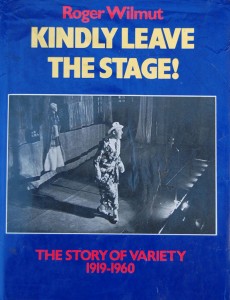
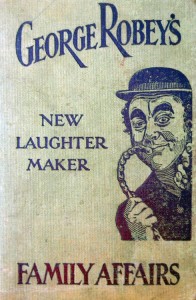
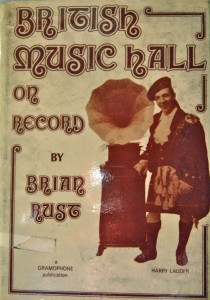
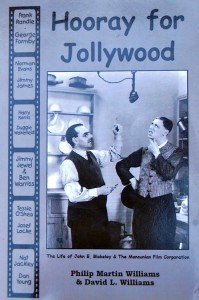
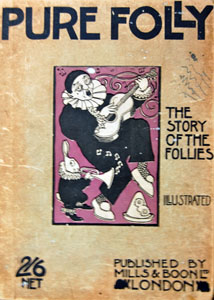
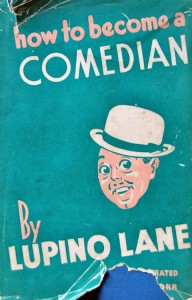
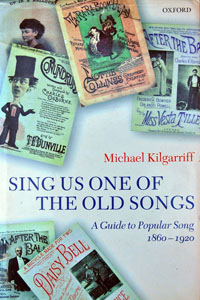
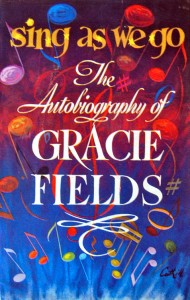
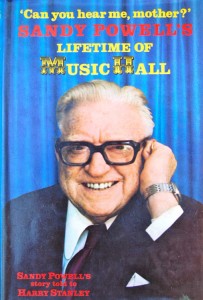
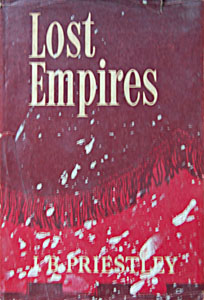
stephendee
| #
Doesn’t ring a bell with me, Stefan, tho it’s a very typical Sarony line. Anyone? Stephen
stefan Beard
| #
Just been reading the Leslie Sarony piece. Absolutely fantastic. Well done. A question if you don’t mind. Does anyone know the the title of the Leslie Sarony song that has the line “Oi ! how you gettin’ on? ” in it ?
ruskimic
| #
I do hope you can help me. I have been searching for many years for my Great Uncle Mr Albert Edward Rayner who went under the name of Dan Rayner. I believe he worked the Music Halls but I do know for sure he worked with Fred Karno. When Charlie Chaplin left Fred in America over a Pay dispute the American backers of the tour insisted that my Great Uncle Dan Rayner be called over from England to take Charlie Chaplin’s Place. It appears Dan was liked more at that time in America than Charlie was. Another man in the troupe at that time was Stan Laurel. When the show folded Dan was asked along with Stan to stay in America. As we know Stan stayed and found he fame and fortune. Dan however chose to return to England. He was last that I can find in a play Dick Wittington at the Empire Theatre advertised in the a local paper in Durham in 1948. Unfortunately I have not been able to find when or where he died. I am hoping that maybe on your search you came across some info on Dan Rayner. I live in Australia so am unable to search all the death records for England with out it costing me a fortune. So any help you maybe able to give me would be really appreciated. I know he went to America twice and once to Australia and also once to South Africa. I do know he was married to a lady named Barbara Robinson and they had a son Conrad Paul Rayner but I have been unable to find any thing out about these two members of his family. I do know they separated before 1935 and he lived with another lady named Phyliss but as to her last name I have no idea. I have been searching for nearly 10 yrs now and I don’t think there is any thing left on the net that can help me. You it would appear maybe my last chance. I will keep my fingers crossed that you did come across some info on him or you know some one that maybe able to help. He went to America in 1913 on the Lusitania and it shows at this time he is married. He then returns to America in 1914 on the ship Adriatic. I do believe he also did a radio show after 1935 for quite some time but do not know the name of that show. I do hope you can help in my search for my Great Uncle.
I also might add my great grandfather was Edwin Richard Barwick. He was also a Music Hall performer and appeared in the first Royal Command Performance. If you get the picture and Index to that even you will see him standing next to Pavlova. I would love to hear any information you may have found out about him. I do believe he was one of the first members of the charity named water rats, I know star was spelt back wards to get the rats part. Edwin did a lot of work for this charity in his day. What I would love to know is if there is any recording of Edwin Performing and if so how I would go about getting a copy or seeing any recording. I do have a photo copy of an old theatre bill with my grandfathers name boldly written on it. Again any help would be appreciated.
All the best and I look forward to hearing back from you in the near future
Kim Rayner
my email address is ruskimic@yahoo.com.au